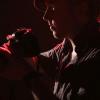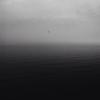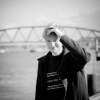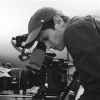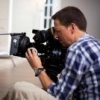Search the Community
Showing results for tags 'green screen'.
-
I am going to use a green screen to create video of 2 people dancing to be superimposed in a scene with 2 other people dancing. I am an amateur/rookie at this. I bought a 13x8 Westcott x-drop green screen for the project. Can anyone suggest lights by brand and model if possible for lighting the screen? Also, if I want to use lights I already have, is it better to use LED, tungsten, fluorescent? And do I need shadowboxes? Any help would be appreciated. Thanks.
- 3 replies
-
- green screen
- lighting
-
(and 1 more)
Tagged with:
-
Hello, I'm using Resolve 18 to key some Canon Raw green screen footage. Everything goes relatively smoothly until I adjust the Matte threshold. The Alpha channel looks pure white, but the footage gets black splotchy / grainy. I can't find any work arounds to get rid of this. I believe my footage is exposed well. I tried a quick Colorspace transforms (guessing settings) in my node tree to see if more saturated footage would help, but it did not. I tried as many different workflow attempts as I could find. I used a clean plate as the keyer color, and the footage still gets the black dots. When changing view mode to intermediate result it did seem to get rid of the black dots but the green background came back at half transparency, so I assumed it wasn't working? I also tried the 3d Keyer and got a nice result with no grain, but the mask had a green outline. Is this a better keyer than the delta?
-
- green screen
- keying
-
(and 2 more)
Tagged with:
-
Hello everybody. I just got my chance do a music video for an accomplish singer. I will be the cinematographer. There are two shots the director wants to get. Fortune cookie is the main element in the video and the story. The director wants to see the shore line filled with fortune cookies as the waves are bringing them to the beach. As an alternative we can use a mountain of fortune cookies at the beach. Since we don't have permit to shoot at the beach and throwing the fortune cookies in the ocean is not possible I am trying to find a way to achieve this by using practical effects. The biggest problem is that we need to shoot it this coming Tuesday. Not much time. I already rented a Laowa 24mm macro probe lens to get some of the shots we need. I was thinking of using this lens and forced perspective to get the effect of mountain of cookies. I am thinking of using a table covered with the same sand from the beach we will shoot. Then make a mountain of cookies on the table. By placing the singer in a distance place I am hoping I can get that shot. It would be better if we had smaller scale of fortune cookies but in this case it will look like a mountain of giant cookies. I am assuming that I can get this shot. How would I achieve the cookies hitting on the shoreline by the waves? The director herself will edit the video and I don't think she can do it in post. I can help her maybe if I can get some advice on how to shoot it. I was guessing that maybe we can do something with greenscreen. Maybe have them swim in a small pool in front of a green screen and some sand. I don't know. If anyone has idea please share it. I would really appreciate it. Thanks in advance.
- 10 replies
-
- practical effect
- green screen
- (and 3 more)
-
Hi everybody I am preparing a shooting as a gaffer, on a non-stage interior and I am looking for the best way to light a 6x6m. (20x20') green screen and white screen. Here is the camera configuration: Red epic dragon (maybe an Hellium sensor, depending on the production department) 25 fps 1/250 ISO 800 Zeiss CP2 The topic of the video is a free-fall simulator demonstration. We are shooting at night for day, in an area from a shopping center measuring 14m. large x 7m. long x 14m. tall (46' large x 23' long x 46' tall). There are not structures to hang on the fixtures. On the back there is a window as big as the wall (46x46'), against a steel structure where we are going to hang a 20x20' green screen. We have, of course, a tight budget so we cannot afford a trilite structure (stage columns...), which is far more expensive as we thought (5K€). On the other side, we can afford 2 articulated boom lifts, high and long enough to top light the green screen. I am thinking to hang the fixtures at 8m. (26') We are using HMI fixtures to key and backlighting (3 Arrisun 2,5K), as well as 2 Skypanels S60C. So... I am thinking about using 2 "K5600's Alpha 4k" with the "space beam/space light" configuration, the first at 2 meters (6,5') from the edge of the screen, and the second at 4 meters (13'). So I am wondering if: 1. Is it enough to evenly light the 20x20' green screen, 2. Will it have enough output to properly light it. We are only doing a few shots on green screen. After that, we are going against white screen (same area). Do you think the same configuration will be enough to have a nice white background? I hope my explanation is good enough. I can upload a plan if you need. Thanks for your feedback! PS: I apologize for my english mistakes.
- 1 reply
-
- alpha 4k
- space light
-
(and 3 more)
Tagged with:
-
I have recently accepted a project that takes place entirely in an antique rail car. Because the train is located at a transportation museum it does not have the ability to move. Another challenge is the film is set in Morocco. The initial plan is to use green screen to key in the exterior. My bigger concern at the moment is how to make the train look like it is moving without any hydraulics or mechanical mechanisms. I would appreciate any tips or experiences others have had shooting stationary vehicles with green screen and getting a realistic cinematic result. Both camera and lighting tips much appreciated
-
Greetings, First off, my apologies for not writing a shorter and more concise piece. I will revise this post as time permits - Think of this as a living document. During a recent creative meet for an upcoming short, the idea emerged to simulate parts of a living room appearing on fire during a dramatic dialogue scene The thought is to simulate fire illumination and smoke and composite pyro physical effects plates in during post. We will be shooting this in 8K anamorphic at low compression ratios Think of the end sequence of "Barton Fink" and some scenes from "Synecdoche, New York" This is for a micro/no budget production by former film students & both semi pros and serious pros as a portfolio/fun/festival/creative piece. We are using our own camera and a lot of gear, and renting additional lights/grip/stuff as need WE HAVE NO INTENTION OF SETTING THE SET ON FIRE NOR IS ANYONE PAYING US TO MAKE THIS The idea we are kicking around is that during a sequence of a couple locked off shots, two people are sitting on a couch exchanging drama rich dialogue, and in the background(maybe out of focus) we see curtains and the wall on fire. additionally, we also want to have fire/smokes elements appearing in front of the talent. Think of the subjects as being sandwiched between fire elements. Something sorta like these, but as static/locked shots Barton Fink Fire scene: https://youtu.be/P_8O-iDvlmA Synecdoche's Burning House https://youtu.be/SF9yFCSICE8 How to set a living room on fire: https://youtu.be/yLqVmBeJre4 Our thoughts on how to achieve this look so far: 1) bouncing a 1K tungsten (maybe a couple of 650s) off a gold reflector to simulate the fire flicker - this would be similiar in application as using a silver reflect to simulated water reflection from moonlight 2) candles + incense in front and underneath the frame to provide heat warping and some smoke during principle 3) Make fire plates and luma map - Match and duplicate the angles/distance of the camera in relationship to the set, hang curtains in a dark area in front of black, such as in a cleared warehouse or on a paved surface somewhere remote (maybe at night), make sure they are similar in setup to the hot set, set them on fire - then luma map the fire in post as a layer effect for the backgrounds 4) purchase and use prematted green screen fire effects for additional layer/post work 5) shoot the scene with the actors on set with a green screed behind them, then shoot it again w/out the actors there, to more easily control the layer effects in post 6) Hazer to, well, add haze (we'll be using one anyway for depth/texture, but may kick it up a bit for this part) We may do the composting in aftereffects, as none of us have experience with Nuke. We absolutely welcome the addition of any interested nuke/fx compositor in the bay area who is interested in building their portfolio and/or willing to contribute to a creative project for a reduced rate. Push comes to shove, we are willing to work something out for payment, it just may delay our initial shoot, as this is all out of pocket and none of us are in the six-to-seven figure salary club. We will most likely not use a generator on location We are still a few month away before we can begin developing the shoot schedule/etc. We want to explore the possibility as a narrative component near the ending before finalizing the script (twenty pages) Thank you for any and all advise and guidance. It is very much appreciated.
-
Hey Guys, I don't really have a vfx background, and it would be fantastic if you could help me out! Attached below is a still (and a link to a video) of what I am trying to achieve. I'm looking to shoot a music video that uses forced perspective (mainly band performance stuff), and I am not quite sure how to go about making it look right. To give a little more context, I'll be shooting with an A7sII camera. My questions are as follows: 1) Did they use a green screen for the people? 2) How do you make the person match with their background? I know lighting is a huge part of it, but I'm referring more to field of video, camera angles etc. Is there an equation that involves the height of the person/building, camera focal length etc. 3) Some of the shots in the video are moving... Is this a fake camera move done in post? Was there a lot of compositing involved? Can this be done practically without heavy post work? 4) I've read that if you're trying to make a person look large, you should film them in slow motion to give the illusion of a large body moving. My question here is with my camera's sensor constraints: I would like to shoot the back plate in 4k for maximum sharpness and better grading (shot full frame), but if I film the individual in slow motion, I'd be working with the equivalent of a super 35 sensor. How can I reconcile the two images to make sure that they visually match? 5) Say I shoot a scene that is back lit: I would have to incorporate the shadow of the person in the shot. Any tips? 6) I need to do this on a small budget: Any tips on achieving a good product cheaply would be greatly appreciated! I know I asked a lot of questions, but I'm having a difficult time finding the information I need online. Thanks for your help! -Sam Link to video:
- 4 replies
-
- forced perspective
- music video
-
(and 5 more)
Tagged with:
-
Dear wisest of cinematographers, In the course of my matura I am required by the state to write a 40k-60k characters long academic writing about a subject of choice in form of a question. The question that I came up with a year ago was: How does the job of a cinematographer in a project using almost only green screen change? (As seen in Gravity or most parts of Avatar) So this in mind I then started researching and writing. In order to finish my writing I am now asking you, the community, for an answer to that question, a conclusion if you will. Cheers, Laurin H.
-
- Green Screen
- Cinematography
-
(and 1 more)
Tagged with:
-
Good day Please see the following link to a scene out of the 2009 film Mr Nobody filmed by Christophe Beaucarne. http://www.youtube.com/watch?v=90CpBg7J-DY I would like any advice on shooting a shot similar to the following scene: A character walks towards a mirror in a room, the camera follows from behind. We see the character look at himself in the mirror. The camera tracks into the mirror and it moves to show a full frontal POV shot of the character looking directly into the camera, as if he is looking at himself in the mirror. The camera then follows the character out of the room, even though it appears as if the camera is moving further into the direction of the mirror. I was able to work out that the character is looking into, what was on set, a green screen. By excellent blocking, the actor was able to mimic his movement that was taken on another shot almost perfectly (a very small delay is seen in his head movement when looking towards screen right). My question to the forum is whether anyone has advice for a cinematography student shooting this scene for a short film on how to pull this shot off. How is the shot taken that was masked in the green screen? i.e. the “reflection of the mirror” shot. Was the camera in a static position until the movement took place where the camera moves around to face the character directly face-on? Did the production designer have to “flip the set” in order to make the shot in the mirror look like an actual reflection? How does one block an actor that well when he is only looking into a green screen and has no reference point? I have a cricket dolly and steel tracks as well as a steadicam available to shoot this shot, so either piece of equipment could be used to pull off this shot. I apologise for the long post but there are many questions that I am asking myself, and for the life of me I cannot exactly figure out how this shot was achieved so seamlessly. Regards Stephan Guldenpfennig
- 17 replies
-
- green screen
- mirror shot
- (and 3 more)
-
Greetings Cine-Buffs My next short film is a one room set up, and requires the room to be filled with large movie posters on the wall etc. Has anyone had experience with using green screen for wall posters or billboards or anything similar? and if so how would you go about shooting this and then the post production on this? Any help would be greatful!
- 13 replies
-
- green screen
- blue screen
-
(and 1 more)
Tagged with:
-
Hello! I am working on a project at the moment and need some help deciding on a way to make the background. The location is a set of a crossing at a road and i need it look as though the background is a continuous street/city. The background itself is never going to be in focus but will be in shot from time to time (At least 3 of 4 directions). The street is 11m wide and the centre of the crossing is 20/30m from the background. I have 3 options that i am considering. A. Printed sheet with the image of the background B. Green screen C. Rear Projection I am just trying to figure out which of the 3 options would be the most effective/efficient way to create my continuous street background. Thanks.
- 8 replies
-
- rear projection
- green screen
-
(and 1 more)
Tagged with:
-
I'm new at this and have a quick question that maybe someone with more experience could give me a heads up on: I need to shoot an actor (full body + shadow) against a green screen INSIDE. That part is okay. Problem is I need to make it look like it was shot in sunlight from a shadows point of view. When composited, the studio light gives distorted shadows because of the close proximity of the light to the subject (a few feet) as opposed to the backplate (the sun, a couple of million miles). In CG (my previous gig) this light would be called 'infinite light'. How do I get parallel light (infinite light) crisp looking shadows inside my space which is 14' high. Can it be done & how? I've tried researching the net but maybe I'm not using the right keywords.
-
Hi there, For a new film I'm shooting we need to shoot a 'limbo' scene, where one of the characters in our movie is essentialy floating through empty space, nothingness. Now I'm new to visual effects cinematography, and my question is: how do you do it? I have two possible scenario's in my head: 1. We hang the actor in a theather in a special harness, and we film him infront of a white screen / green screen. We use a steadycam to float in a subtle way infront of the actor, so it will seem like he is floating. Problems: Our actor is quite heavy, and you will probably see it that the actor is hanging? 2. We put the actor on a green cube/table on the ground n front of a green screen, in a laying position, with his legs and head free above the ground. We will then film him from the side, maybe with a steadycam so we move the camera in a subtle way, so it looks like the actor is floating. The actor will have to be quite strong for this I guess to sell the effect. Problems: Will this sell the effect of a floating person? He doesn't have to look like there is no gravity, but the character is just floating there. Hope someone here can give me some tips and advice! Cheers, Twan
-
Hi, I’m looking for a car cinematography specialized DP for a high end SPEC commercial. Green screen experience is required as the featured car will be driven on a large green screen cyclorama. Although a car specialist, this person must be good at lighting people as well. The shoot will take place on July 25-26 in Los Angeles. Non-Union shoot. Pay negotiated upon experience. Please apply only if you specialize in car cinematography. We need to confirm someone ASAP. If interested, please email a link to your reel/portfolio to crewapplications@mzo.tv Thanks.
-
- car
- cinematography
-
(and 5 more)
Tagged with:
-
I have an upcoming project where I've been asked to film floating blue orbs around the talent a la "Starman". My initial thought is to shoot anamorphic, float a battery powered small source on some monofillament, and composite/track over the source with a light aura of sorts (retaining the flare). I think this MIGHT work, but in these examples there are clearly larger sources being used. They also seem to be coming from relatively the same area as the orb itself. Due to the obvious keying/compositing (you can see the black matte lines when watching the film around the actors/windows) I was thinking maybe they keyed out a rod holding the light painted or wrapped in green? That would only really make sense with the shot from behind them. Any attempt to contact the guys who shot these scenes has turned up unsuccessful. Might anyone have a better idea to achieve this effect? Obviously cameras are quite a bit more sensitive now. So, a smaller, dimmer source isn't out of the question. Heres a video link to anyone interested: Camera/lens package has yet to be decided. Thanks!
- 5 replies
-
- visual effects
- orb
-
(and 4 more)
Tagged with:
-
Hello to all, I need to shoot an LED TV, the content will be added in post production so it needs to be a clean Green for keying, however I did some tests and the Moire Patterns that appear are unbearable. Im shooting on the Red Dragon so it is not a compression issue. Any recommendations on how to deal with the problem? The patterns disappear the second it's slightly soft, but I rather keeping the television in focus. Thanks! J.
- 2 replies
-
- green Screen
- Keying
-
(and 1 more)
Tagged with:
-
Hello I have a project where we need to capture a golf swing which apparently reaches speeds of around 100mph. It needs to be shot green screen and of course the golf club needs to be free of motion blur (as much as is realistic to achieve) throughout its travel. Now I haven't done much high-speed work before but I do know this is going to need a staggering amount of light, not only for the golfer but the green screen too. It will be shot on location so no access to large lights, so my thoughts are to shoot exterior daylight using Phantom. Any idea of suggested frame rates and shutter speeds, and of course light required for this type of work? My low-budget option was to shoot on location with Kinoflo and F55 at its highest frame rate; but I just don't think the golf club will remain sharp throughout. Many thanks Steve.
-
Hi folks I'm shooting a short film in a few weeks and I'm figuring about a car scene with two actor having a dialog while driving, and how I should go about that. First of all, we don't have much of a budget, so a even though a car trailer would be the optimal choice, we can't afford it unfortunately. Any recommendations of how to shoot this? My initial idea was to shoot this infront of a green screen with tracking marks on set, to take advantage of the existing light. By doing so we could use a hand-held camera to add a sense of realism with the background moving (very slightly) in conjunction with the actors and the car. AFTER we've shot infront of the green screen, we go out and shoot the background plates, at the same camera position we used shooting the green screen shots. I believe this could work. Second idea is to shoot the whole scene in front of a rear projection screen. The problem with this I believe is to get a powerful enough projector and not destroying the black when lighting the actors. Also, lighting the car to blend in realistically would also be somewhat of a problem since we can't use any existing light. Third idea is to let the actors drive the car. By far the easiest way to go, but not the safest. Also, they have to be focused on driving the car, so their acting might suffer from that. Any ideas? I would appreciate it a lot! Regards Patrik
- 9 replies
-
- green screen
- on set
- (and 4 more)
-
Hello, I've been reading various forum posts and articles on chroma keying, but I've gotten a bit stuck on the issue of shadows. I know it's preferable to not have any, but what can you get away with? Below are links to photos of my set, which is a circular room currently painted (badly) white, and lit by 8 fluorescent lights that sit evenly around the top of the circular wall. It's essentially a time-slice / bullet-time setup, with 8 cameras capturing the same action from different viewpoints. I want to paint the whole room with chroma key green to isolate the performer, but I'm worried that the faint shadows cast by the performer will cause me problems. The performer will be wearing a black and white costume. http://www.flickr.com/photos/narenwilks/9117291805/ http://www.flickr.com/photos/narenwilks/9119513436/ Now I'm assuming that there is some leeway regarding shadows, judging by some of the things I've seen online, most notably this photo of Keanu Reeves on the Matrix set: http://ralph-dte.eu/files/2011/02/matrix_chroma_key.jpg But how much leeway? My cameras are stationary, and the lighting is constant. Any help would be great appreciated! Many thanks, Naren http://www.naren.co.uk
-
We are looking for a videographer for a quick HD green screen interview. The screen must be big enough to get a wide shot. Time frame is in the next week or two. Email rates and availability and camera details kevin@kandervision.com
-
- Videographer
- Green screen
-
(and 2 more)
Tagged with:
-
We are looking for a videographer for a quick green screen interview. The screen must be big enough to get a wide shot. Time frame is in the next week or two. Email rates and availability
-
Hello guys, Just thought you might like to see my latest music video. It’s not cinematography in a photographic sense; it’s mostly animation. That said, I’m sure lots of the same creative thought processes can be applied to both animation and photography. Let me know what you think. Thanks to Rob Skene who helped me make the video. Some other notes, it was made using Final Cut Pro 7, Blender 3D, After Effects, Photoshop, a Canon 550D,a green screen, and lots of pen and ink. Also it cost 0 money to make. http://www.pjscottentertainment.blogspot.co.uk/#!http://pjscottentertainment.blogspot.com/2012/12/lights-by-feeds-music-video-p-j-scott.html More information about the band can be found on my blog. Don’t forget to follow me on Twitter at: @PJScott89 or on Facebook. Thanks for reading, P. J. Scott
-
- animation
- music video
-
(and 2 more)
Tagged with:






